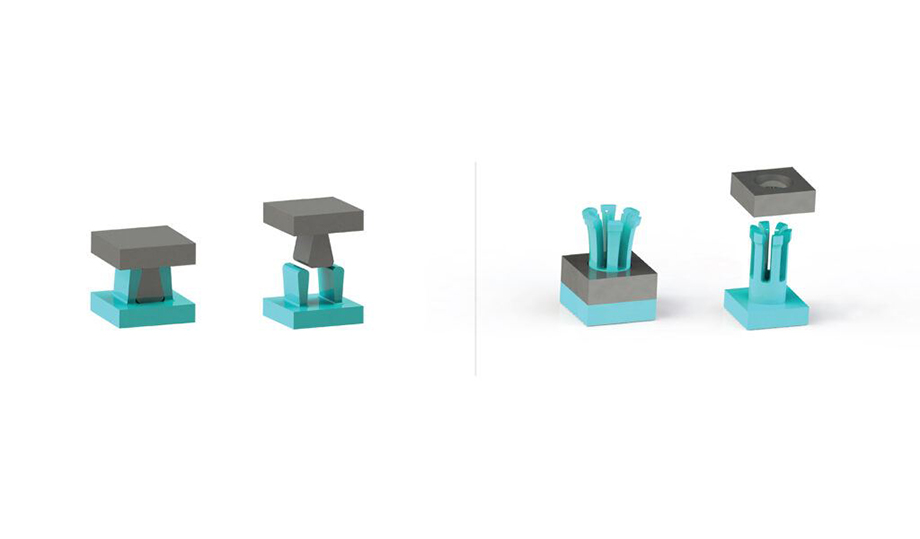Metallic Memories for Lego-Like Joinery
Metallic Memories for Lego-Like Joinery


3D-printed shape memory alloy components may soon replace bolts and welds for quickly securing parts.
As anyone who has tried to pry apart two flat Lego pieces knows, you don’t need bolts or glue to solidly join two surfaces. But there’s a good reason you don’t see Lego-like hardware holding bridges, beams, and buildings together, or in industrial settings: Plastic melts between 100 °C and 200 °C.
But who says snapping surfaces have to be made of plastic? Not Abdelrahman Elsayed, a researcher in the materials science and engineering department at Texas A&M, and lead author of the paper "Active interlocking metasurfaces enabled by shape memory alloys," which appeared in Materials & Design in August 2024. He and his colleagues set out to make a metal version of snapping surfaces.
“Nobody had really thought of using a metal before to create a snap fit,” he said. “So we had to really take a dive deep into the material science.”
When they surfaced, they had decided to use a shape memory alloy—nickel titanium—additively printed. Using an SMA meant that shapes could open up and lock onto each other with heating and cooling of the materials. So, unlike other interlocking materials such as Velcro and Lego bricks, Elsayed’s surfaces require no physical pressure to join them.
Eventually the team came up with two snap-together concepts. Each has two surfaces: one is an array of shape shifting features made of the SMA, while the other has more passive features that fit into the features of the first.
The features of the first design are pairs of little walls that lean toward each other. When heated, they open up so they can receive the wedge-like features of their mate surface. Then, after cooling, they close up again holding the wedges securely. The second design has little pegs with a kind of crown on their tips that hold tightly to the walls of the holes they’re inserted into on the passive surface. When heated again, both features return to their original shapes, allowing them to expand and release the passive features.
The walls of the first design are just a millimeter thick—too tiny to be produced by casting or other typical manufacturing processes. So Elsayed and his team turned to an additive technology called laser-powder bed fusion to create arrays of 64 features on a two-inch-by-two-inch plate. Even with this method they had to adjust their design. A previous version had walled features that were set at an angle to each other for a better grip—but they proved too intricate to be printed properly with the delicate system.
More Materials: Experiments Show Metals Gaining Strength When Heated
“If you choose the wrong combination of scan speed and laser power, you can get into print that has a lot of defects,” said Elsayed. “So you have to be really, really careful in order to get a good print.”
And the potential applications are many. Heat shielding tiles on a spacecraft like the Space Shuttle could easily be snapped on. Structures on Mars could be quickly interlocked into place. And those are just the far-flung possibilities. Anything that needs to be connected to anything else could potentially benefit from the new technology. And the snapping joinery could end up being a lot less expensive than bolts or welds.
ASME Landmark: The Prototyping Technology that Disrupted the World
There is, of course, work to be done before that happens. Elsayed is now looking at the possibility of printing even smaller features for even greater strength. And he’s working on a ball and socket design for easier snapping.
“We are still trying to develop more things,” he said. “And the more we invest in doing that research, and the more exposure we get, the more people might see this as a useful application for the problems that they have.”
Michael Abrams is a technology writer in Westfield, N.J.

But who says snapping surfaces have to be made of plastic? Not Abdelrahman Elsayed, a researcher in the materials science and engineering department at Texas A&M, and lead author of the paper "Active interlocking metasurfaces enabled by shape memory alloys," which appeared in Materials & Design in August 2024. He and his colleagues set out to make a metal version of snapping surfaces.
“Nobody had really thought of using a metal before to create a snap fit,” he said. “So we had to really take a dive deep into the material science.”
When they surfaced, they had decided to use a shape memory alloy—nickel titanium—additively printed. Using an SMA meant that shapes could open up and lock onto each other with heating and cooling of the materials. So, unlike other interlocking materials such as Velcro and Lego bricks, Elsayed’s surfaces require no physical pressure to join them.
Eventually the team came up with two snap-together concepts. Each has two surfaces: one is an array of shape shifting features made of the SMA, while the other has more passive features that fit into the features of the first.
The features of the first design are pairs of little walls that lean toward each other. When heated, they open up so they can receive the wedge-like features of their mate surface. Then, after cooling, they close up again holding the wedges securely. The second design has little pegs with a kind of crown on their tips that hold tightly to the walls of the holes they’re inserted into on the passive surface. When heated again, both features return to their original shapes, allowing them to expand and release the passive features.
The walls of the first design are just a millimeter thick—too tiny to be produced by casting or other typical manufacturing processes. So Elsayed and his team turned to an additive technology called laser-powder bed fusion to create arrays of 64 features on a two-inch-by-two-inch plate. Even with this method they had to adjust their design. A previous version had walled features that were set at an angle to each other for a better grip—but they proved too intricate to be printed properly with the delicate system.
More Materials: Experiments Show Metals Gaining Strength When Heated
“If you choose the wrong combination of scan speed and laser power, you can get into print that has a lot of defects,” said Elsayed. “So you have to be really, really careful in order to get a good print.”
Adding hafnium helps
The shape memory feature of nickel titanium arises thanks to its structure at the atomic level. The nickel and titanium atoms are arranged in a zigzag. When heated, the arrangement of atoms isn’t deformed, but realigned—essentially the zigzag disappears, and the atoms go grid-like. Steel, copper, and aluminum don’t share this property. However, the addition of hafnium to the nickel titanium maintains the zigzag-to-grid phenomenon while allowing the alloy to keep its shape at much higher temperatures. That means that the snapping surfaces could be tuned with hafnium to fit different applications with different temperature needs.And the potential applications are many. Heat shielding tiles on a spacecraft like the Space Shuttle could easily be snapped on. Structures on Mars could be quickly interlocked into place. And those are just the far-flung possibilities. Anything that needs to be connected to anything else could potentially benefit from the new technology. And the snapping joinery could end up being a lot less expensive than bolts or welds.
ASME Landmark: The Prototyping Technology that Disrupted the World
There is, of course, work to be done before that happens. Elsayed is now looking at the possibility of printing even smaller features for even greater strength. And he’s working on a ball and socket design for easier snapping.
“We are still trying to develop more things,” he said. “And the more we invest in doing that research, and the more exposure we get, the more people might see this as a useful application for the problems that they have.”
Michael Abrams is a technology writer in Westfield, N.J.

We've Gone Digital
ASME members can access Mechanical Engineering magazine in its new, enhanced digital format. Everything you love about ME, now everywhere you go.


